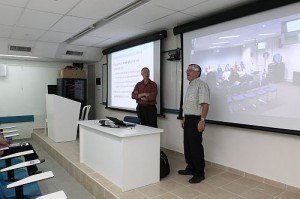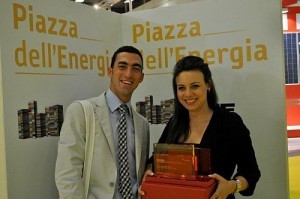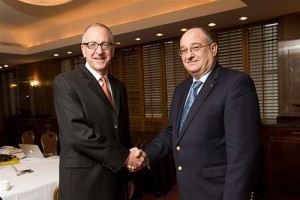Technion Leads the WayFrom: Technion Focus.
By: Prof. Shlomo Maital
“If Moses had turned right instead of left when he led his people out of the Sinai Desert,” goes an old joke, “the Jews would have had the oil and the Arabs would have ended up with the oranges.” We can’t tell that joke any more. Two major gas fields have been discovered offshore, in the Mediterranean, named Tamar and Leviathan. The latter is said to be the biggest gas find in the world in a decade.
Leviathan means “whale” in Hebrew and indeed is a whale of a find – new estimates show Leviathan has some 16 trillion cubic feet of gas, worth (at current European market prices, one cent per cubic foot) over $160 b. The Tamar gas field has an estimated eight trillion cubic feet of gas; it is located 90 km (54 miles) offshore, three miles deep, and its gas will reach Haifa in 2013. Leviathan is 130 km (78 miles) offshore. Many experts believe that in addition to the gas, there is also offshore oil.

The question now fiercely debated, is, what should Israel do with this new, incredible windfall? Liquify it and export it? Use it for gas-based industries, like petrochemicals? But first, a more pressing dilemma exists. Where will Israel find the hundreds of petroleum and natural gas engineers needed to bring the gas to shore safely and efficiently, and then process it optimally? This is a huge, enormously difficult and extremely costly challenge. Perhaps because Moses made that wrong turn, Israeli universities do not teach petroleum engineering.
That is, until now.
At the initiative of Technion President Prof. Peretz Lavie and Senior Executive Vice President Prof. Paul Feigin, Technion has moved with alacrity to launch a Master of Engineering program in Energy Engineering, with specialization in natural gas and petroleum engineering. The program is open for enrolment and formal studies will begin on December 28, 2011. For 18 months, some 25 engineers will study drilling engineering; production, transportation and storage engineering; or reservoir management, at their choice. Haifa University is an active collaborator through its Department of Marine Geosciences.
As Feigin notes, “the efficient, safe and environmentally responsible exploitation of [Israel’s] natural gas reserves is the major engineering challenge facing the State of Israel in the coming decades. The Technion, as it has done throughout its history, is taking the lead in providing the education and developing the know-how in order to meet this challenge.”
The director of the new program is Prof. Yair Ein-Eli of the Faculty of Materials Engineering. I asked him where the graduates of the program will be employed. He told me they would work for exploration companies (there may be vast additional reservoirs of oil and gas yet undiscovered), drilling groups, consulting companies, entities that process, transport and distribute the gas, and of course, for governmental ministries (Infrastructure, Finance, and Industry).
Finding top experts suitable to teach in this program was not easy. Technion found them at Technion itself, and at Haifa University, as well as at America’s University of Houston and Colorado School of Mines, and Norwegian Technological University. Both the U.S. and Norway have vast experience in exploiting oil and gas reserves.
Technion has a long history of anticipating Israel’s needs for engineering skills and with vision, supplying them. In November 1950, Prof. Sydney Goldstein, then head of the Aeronautical Research Council of Great Britain, arrived in Haifa to become dean of Technion’s fledgling Aeronautical Engineering Faculty. For a nation with barely a million people, and per capita GDP of $1,500, some thought this Faculty was folly. But 38 years later, on September 19, 1988, Israel became the eighth country in the world to launch a satellite. The effort was led by Technion-trained aeronautical engineers and students. Today space is a potential growth industry for Israel.
Technion petroleum and gas engineers will bring home the gas. Technion chemical engineers will show Israel how to best exploit this resource. And Technion graduates in management will lead the businesses that do so.
We owe Moses an apology for that tired joke. He knew precisely where he was going after all. In the end, we got the oranges – and the gas and oil as well.
Prof. Emeritus Shlomo Maital is a senior research fellow at Samuel Neaman Institute for National Policy Research, Technion. This article is based in part on Maital’s Marketplace column, Jerusalem Report, May 9, 2011.
© 2011 Technion-Israel Institute of Technology, Division of Publ

 The Technion and Monash University of Australia have launched a series of joint lectures, facilitated by the installation of advanced multimedia equipment by TNN Telecom. Monash University is the largest university in the southern hemisphere.
The Technion and Monash University of Australia have launched a series of joint lectures, facilitated by the installation of advanced multimedia equipment by TNN Telecom. Monash University is the largest university in the southern hemisphere.
 NEW YORK CITY/HAIFA, ISRAEL – Cornell University and The Technion – Israel Institute of Technology announced today a new partnership to create a world-class applied science and engineering campus in New York City, as outlined by Mayor Michael Bloomberg.
NEW YORK CITY/HAIFA, ISRAEL – Cornell University and The Technion – Israel Institute of Technology announced today a new partnership to create a world-class applied science and engineering campus in New York City, as outlined by Mayor Michael Bloomberg.

